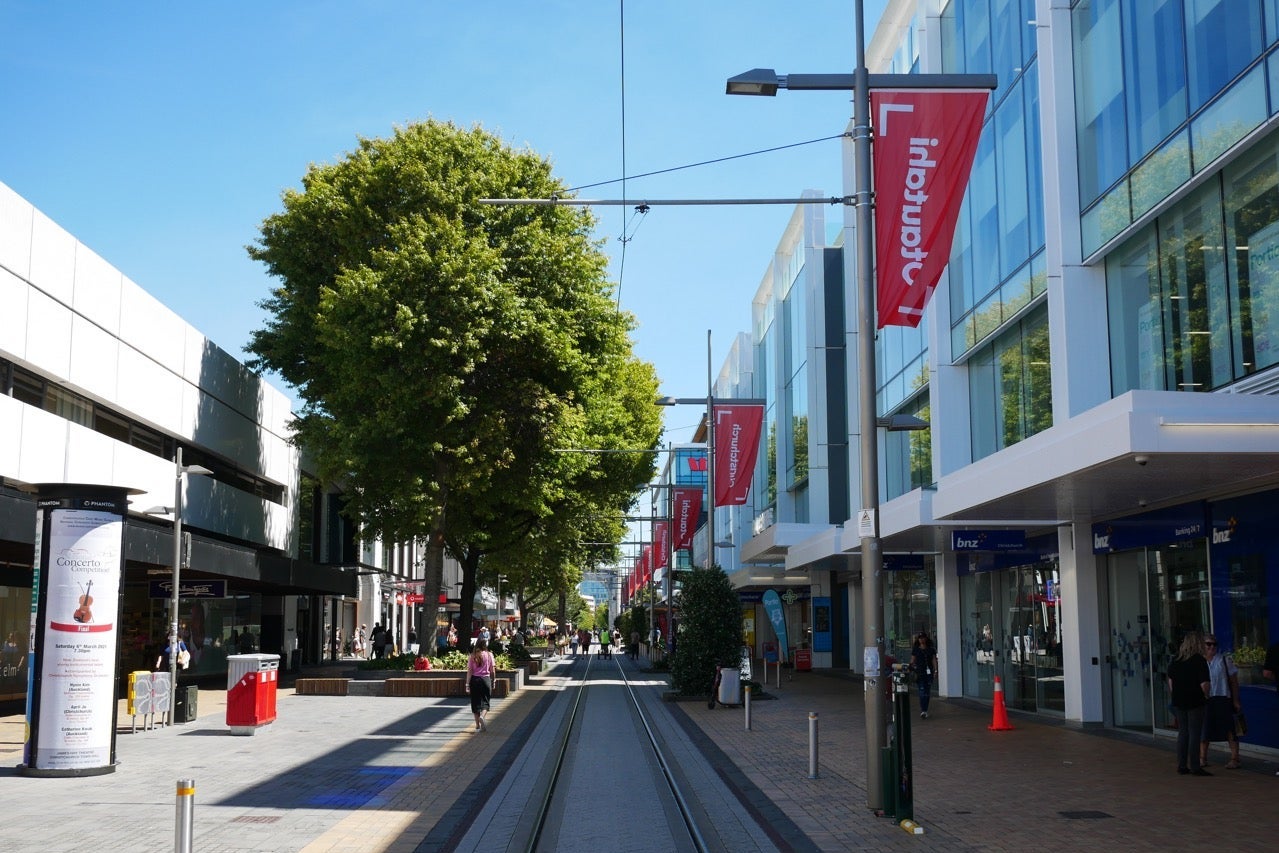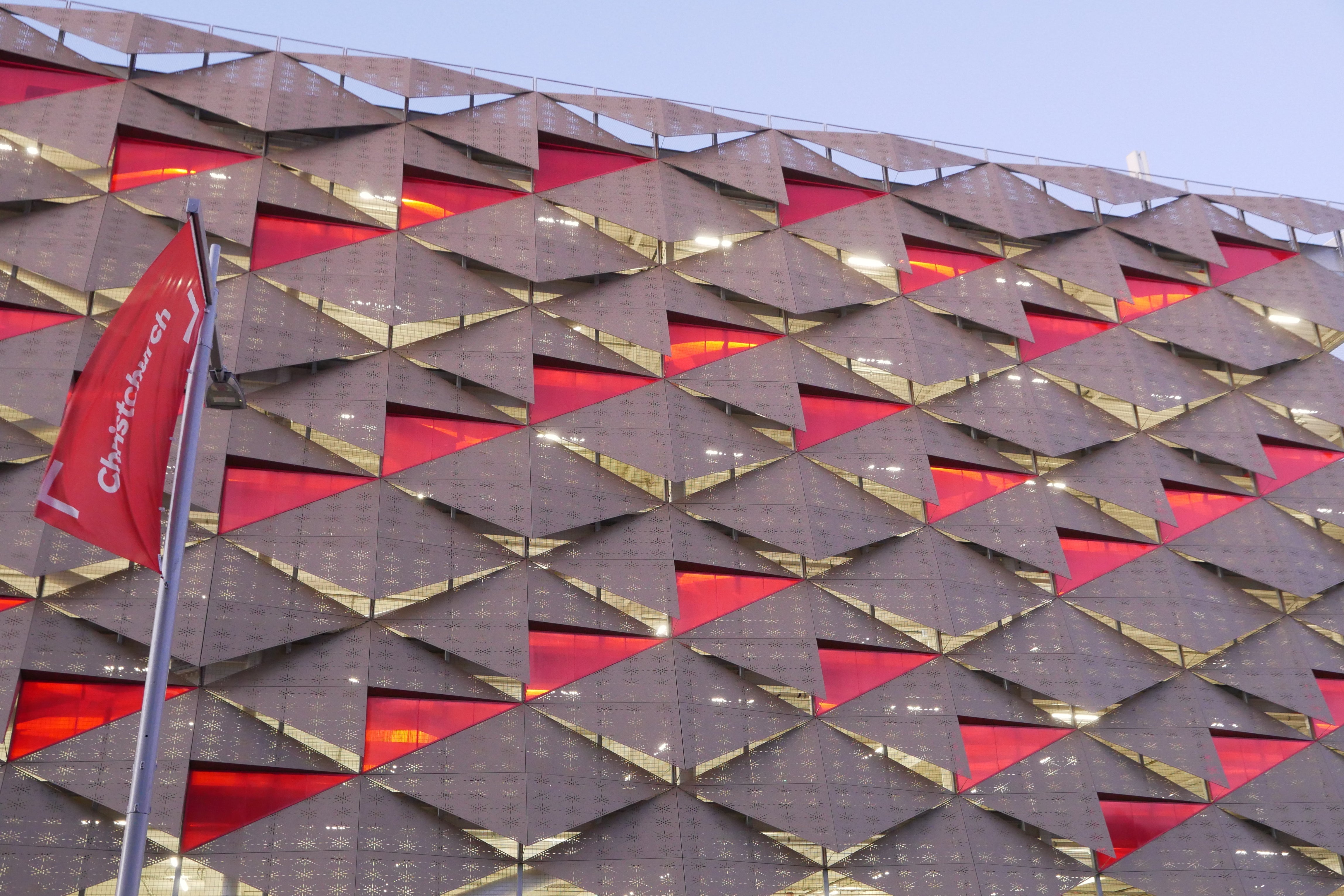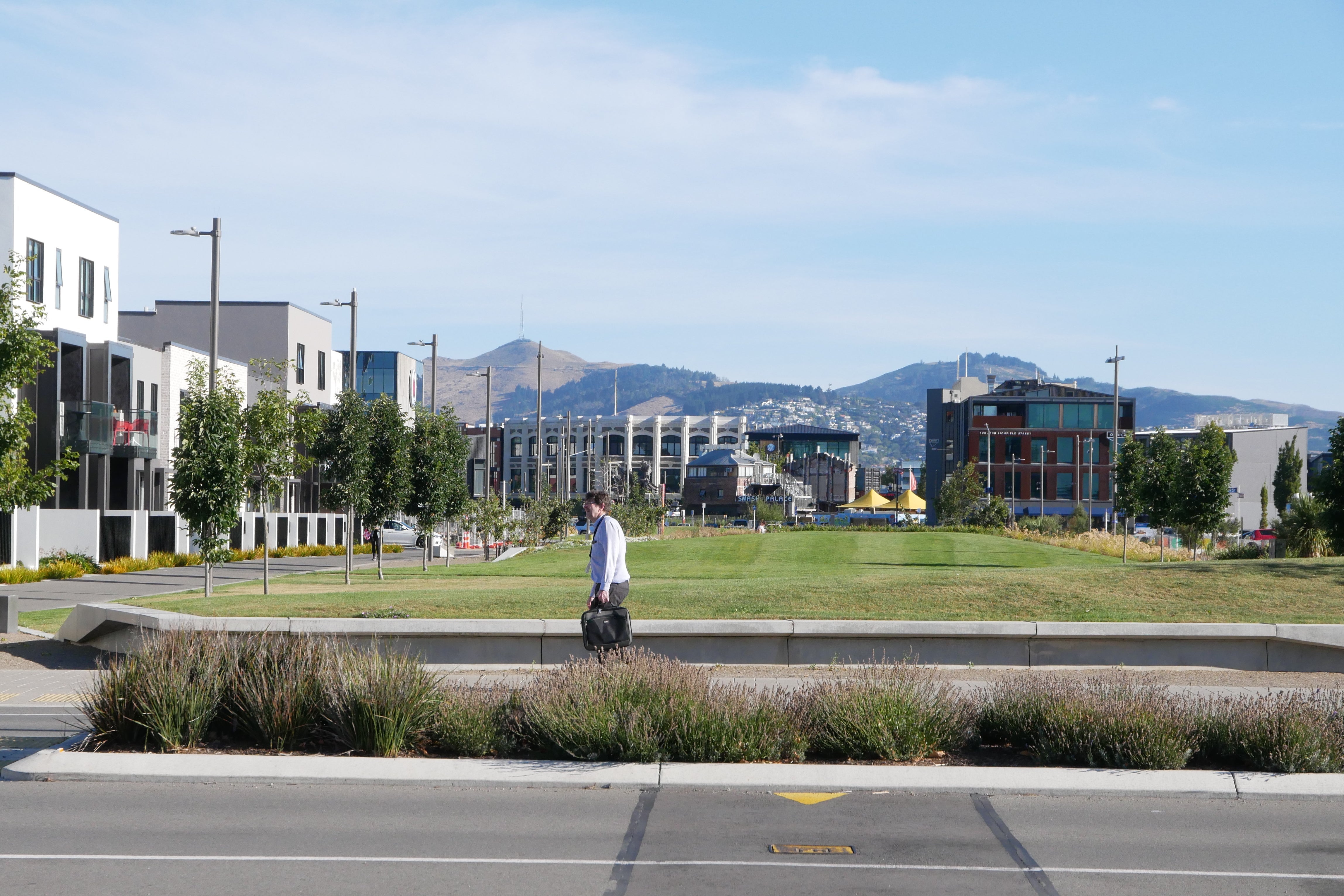On a recent summer evening, the South Frame, a newly built pedestrianized corridor near the center of Christchurch, New Zealand, was eerily quiet. The only two living souls I saw were a couple of vulnerably housed people, using the park benches for quiet kip. Unlike much of the rest of the world, these streets weren’t empty due to lockdowns or stay-at-home advisories. After a strict national lockdown in March and April of 2020, New Zealand’s South Island—where Christchurch is the largest city—hasn’t had a case of community COVID transmission for close to a year. Downtown Christchurch isn’t empty because of COVID. It’s empty because of twin catastrophes: Ten years ago an earthquake leveled much of the city—and then the local and national government botched the rebuild, squandering a golden opportunity to transform Christchurch. How did it happen, and what can other cities trying to rethink or rebuild learn from our mistakes?
The Feb. 22, 2011, earthquake killed 185 people and had an unprecedented impact on the built environment of Christchurch, a city built by white settlers on drained swampland. More than 1,200 buildings inside the central four avenues were destroyed by the quake or by demolition crews in the years after. In the suburbs, a process called liquefaction was just as devastating. As the ground shook, water and sand squeezed up through the soil to the surface, leaving the soil to subside into the space the water had vacated. Houses slumped, and roads folded inward like the icing on a failing chocolate cake. In the hardest-hit eastern suburbs, the government eventually bought out and demolished about 6,500 houses, upending countless families.
One of the champions for this area of the city, which is demographically poorer and browner than the rest of Christchurch, was then-opposition MP Lianne Dalziel. She left Parliament in 2013 to contest the mayoralty, won, and is now in her third term. When I asked her about lessons to come from the rebuild, she immediately mentioned “Share an Idea,” an inclusive project run by the City Council in the months following the quake. “It was an opportunity for people to submit ideas about how they might reimagine their city,” she said. More than 10,000 people contributed over 100,000 ideas, which the council used to influence its draft central city plan. Share an Idea empowered the community, produced concrete recommendations for the future, and won international accolades.
In late 2011, the national government rejected that community-generated plan. Sidelining local politicians, the government came up with its own version, formulated behind closed doors in about 100 days. With much fanfare, the government announced a “Blueprint” for Christchurch that promised a brand-new city peppered with big-ticket items: a stadium, a library, a convention center, a giant indoor sports facility. The CEO of the government agency set up to oversee the rebuild said that “this new city will absolutely set an international benchmark for urban design, innovation, and livability.” The minister in charge, Gerry Brownlee, noted that “the plan and its implementation are being watched by the rest of the world.”
For a brief moment, the rebuild of the city did attract international media attention. This coverage wasn’t about the Blueprint. If you don’t live in New Zealand and you read about Christchurch in those years, most likely it was about the creative, guerrilla projects that popped up in the immediate aftermath of the quakes. Temporary site activations—Gap Fillers—brought life back to the empty gravel lots with music, performance, art, and community participation. These were almost spontaneous events, a community responding to challenging times however it could. They represented the best of the city, and inspired residents and visitors to believe that the new Christchurch that grew from the rubble of the old could be eclectic, engaging, and exciting.

But when the government did eventually get building, these human-scale activities were pushed to the side. Aiming to create the Blueprint’s more compact central city, the government bought up a number of city blocks. Restricting land supply did prevent a collapse in property prices, but those artificially high land values, combined with strict new building codes, restricted private development to a handful of rich developers. The result: overpriced housing and projects that spanned entire city blocks, instead of ground-up development reflecting the needs of the community.
A key plank of the blueprint was selling Christchurch as a destination for international tourists—“The Gateway to the South Island.” But international capital never arrived, and now COVID has halted the flow of visitors to New Zealand for some unknowable period of time. The two largest anchor projects in the Blueprint—the stadium and the convention center—are yet to open.
The Blueprint plan ushered in by the center-right National-led government was about stability. It was about putting Christchurch back together as it was, and telling the world that it was open for business. But the world didn’t really want to know about another midsize Anglo city with an agricultural base. There were hundreds of them already. The world wanted to see the creative revival that briefly made Christchurch vital, and when the Blueprint slowly squeezed the life out of that, there wasn’t much else to draw the world’s attention. Christchurch had the chance to rebuild from the ground up as the first 21st century city. Instead, it often looks like the last city of the 20th century.
Walking Christchurch now, 10 years on from the quakes that have defined the city, you see the rebuild’s successes and failures, set amid blocks that look largely, depressingly unchanged from the quake’s immediate aftermath. The main shopping street, Cashel Mall, has been rebuilt with department stores and upmarket international brands. The heritage tram trundles along here, and window shoppers bump shoulders with buskers and beggars, who are a much more visible presence since the quakes. On the south edge of the mall is the bustling Riverside Market, at its heart a food court, but presented (and priced) like a farmers market. It was a popular tourist destination since opening but, even without international visitors, is well frequented by locals and domestic tourists. Follow the Avon River north past Christchurch’s best building, the brutalist Town Hall, which was magnificently restored after a groundswell of public support prevented it from being demolished. Farther along the Avon is another much-loved public space, the Margaret Mahy Playground. With four different play areas, each themed on an aspect of the Canterbury region’s natural heritage, this free play space has been one of the few unreserved successes of the rebuild.

If you turn and face the Port Hills at the playground, you will be looking south over the Frame, the largest chunk of downtown land the government bought up. Most of it is green but empty, still waiting for progress to catch up with it. A few residential developments dot the Frame, almost all of them overpriced, even in the context of New Zealand’s overheated property market. The city’s goal, repeated frequently during the rebuild, has been to have 20,000 people living in the central business district by 2024; at last count there were just over 7,000—the same number as before the quakes.
Plenty of the central city still consists of empty lots, used now as car parks with hardly any cars parked on them. In some parts of the city, there are still buildings waiting for either the repairer’s scaffold or the wrecker’s ball. In the historic center of the city, the crumbled Anglican church that gives Cathedral Square its name still sits with its west face open to the elements, the world’s most ornate and controversial pigeon coop.
Looking out over the crumbling cathedral is the undisputed star of the rebuild, Tūranga, an open, welcoming public library and community space. It is one of the few ideas, Dalziel pointed out, to come out of the Share an Idea process that made it into the Blueprint: “It’s an example of the sort of thing you get when you design with the input of the people who are using it.” Children asked for a “Harry Potter staircase,” and a Harry Potter staircase is what they got. Another reason for its success is that it is one of only two buildings in the rebuild designed by an architect from outside of Australasia: It was made by Schmidt Hammer Lassen, a Danish firm that is a world leader in designing libraries. This partnership of international experts with local government and iwi (a Māori term often translated as “tribe,” identifying those who have a strong association with a place—in this case, Ngāi Tahu and Ngāi Tūāhuriri) represents an inclusivity absent from much of the rest of the rebuild.
A 2019 survey of 30,000 Christchurch residents found that just 29 percent of them thought that the city was better than it was before the quake. I lived in central Christchurch for about a decade, both before and after the quake, and I have to agree with the majority. Rebuilding this city was an opportunity to make something great; instead, 10 years on, we’re still talking about Christchurch’s potential. What lessons can other cities, rebuilding from disaster or redesigning in anticipation of change, learn from Christchurch?
Firstly, don’t take too long. With the central city closed down and cordoned off for years, Christchurch residents learned to live without it. The suburban malls got even bigger, gorging on custom from a city devoid of a retail core. The boundaries of the city spread farther and farther out across the plains. When those thousands of families displaced by liquefaction needed places to live, there was no affordable housing in the CBD. So they went elsewhere. By the time the city started to reopen, the fundamentals had shifted even further in favor of the suburbs.
Plan, but don’t dictate. At times, the rebuild authority seemed to get bogged down by its own rules. The first building that was built in the CBD post-earthquake was pulled down a year later, as it didn’t fit within the Blueprint plan. It was leveled so a road could be widened by a few meters. The site still sits empty to this day. The Blueprint also tried to force similar types of activity to cluster together in “precincts.” Perhaps the most egregious example of this was the much-mocked “innovation precinct,” where visionaries and entrepreneurs and dreamers were expected to come together in a two-block area arbitrarily set down by government decree. The result is that Christchurch now has the dystopian-sounding Justice and Emergency Services Precinct and the truly inspirational International Rental Car Precinct, while the Performing Arts Precinct and Ngai Tahu Cultural Precinct have been quietly shelved.
These precincts are a perfect example of the greatest failure of the rebuild. They fundamentally misunderstood the organic, spontaneous nature of cities. Places evolve because of the people who live and work in them. You can influence a number of factors—economic, environmental, planning—but you can’t force people to do things that ultimately don’t make sense to them. The Blueprint looked to serve property, developers, and a few other vested interests. The result: a rigid plan that privileged out-of-town businesses and big-ticket projects but priced average people out of the city. The CBD now has twice as much space in buildings given to car parking as to residential living space. What kind of 21st century city is that?

With every city in the world looking to rebuild its economy as we emerge out of COVID, Christchurch shows the importance of placing people at the center of plans. Ask the people what they want, and listen to what they say—even if they tell you what you don’t want to hear.
Standing at the top of the stairs at Smash Palace, the city’s best bar that is built around a converted school bus, I can see three of my old flats. Well, I can see where they were. Sure, they might have only been a stone’s throw away from one another, but the fact that 10 years on, there has been nothing built that obscures my view makes me incredibly sad. Places where I ate, slept, drank, fell in and out of love, completely gone, replaced by nothing. It could have been great, and given that there are still wide expanses that haven’t been developed, I guess it still could be. But after a decade, I, like most of Christchurch, have moved on from the city.
